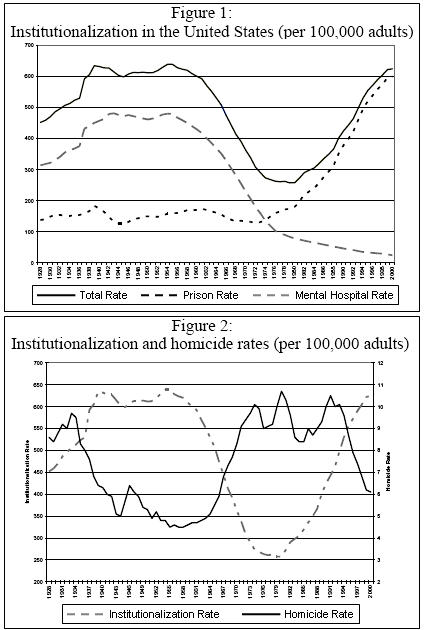John Pfaff had an article in Slate yesterday that takes on “five myths” about prison reform. I don’t have much to say about the article in general, but it did have one very interesting factlet about America’s sky-high incarceration rate:
More strikingly, if we look back historically at the lockup rate for mental hospitals as well as prisons, we have only just now returned to the combined rates for both kinds of incarceration in the 1950s. In other words, we’re not locking up a greater percentage of the population so much as locking people up in prisons rather than mental hospitals.
This comes from a paper written a couple of years ago by Bernard Harcourt, who says that it’s only half true to say that American incarceration rates skyrocketed starting in the 70s. What really happened, he says, is that we’ve had high incarceration rates for most of the 20th century, but it was originally split between a small number of people in prisons and a much larger number of people in mental institutions. In the 60s we suddenly emptied the mental hospitals, crime soared, and then in the 70s we started putting more people in prison. The end result is an inversion: the incarceration rate today is about the same as it was in the 50s, but we have a small number of people in mental hospitals and much larger number of people in prison.
Harcourt discussed these findings in a series of posts at the Volokh Conspiracy back in 2007, making the point that social science research that focuses strictly on the prison population might be missing the larger picture: “Since practically none of our studies on prisons, guns, abortion, education, unemployment, capital punishment, etc., controls for institutionalization writ large, most of what we claim to know about these effects may be on shaky ground.”
If you’re interested in this kind of thing, the whole discussion is worth reading. I don’t have the background to endorse Harcourt’s findings one way or the other, but the raw data is pretty interesting. It’s worth a look.
UPDATE: Crime and punishment expert Mark Kleiman responds here. He says there’s much less to this than meets the eye, and adds, via email: “The explosion of drive-by shootings 1985-1994 simply can’t be blamed on de-institutionalization. More generally, adult homicide has been falling since the early 1970s; it’s youth homicide that surged and receded.”
















